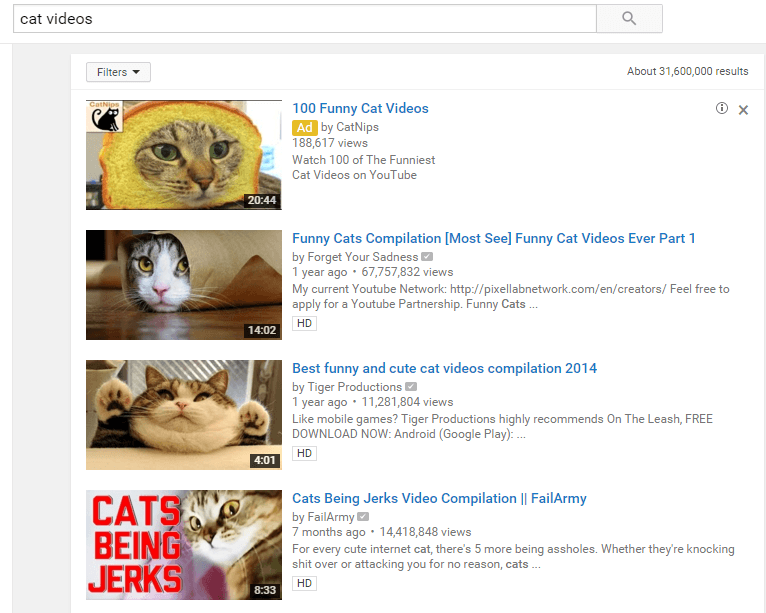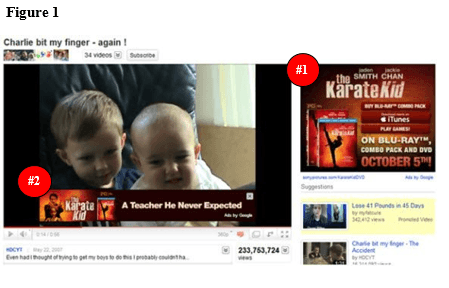YouTube: Struggling to Monetize Cat Videos

After ten years and over one billion active users, YouTube’s ad model is still unprofitable.
YouTube is the largest video streaming website in the world. Each day, active users watch hundreds of millions of hours of video on its platform. Despite the website’s popularity, YouTube has been unprofitable since its inception in 2005. YouTube is a TOM loser because the company’s operating model is ineffective at monetizing its popularity and vast content library.
The Search Engine for Videos
YouTube has a simple business model. The company operates an infrastructure that enables users to create and upload videos to the internet of any length or genre. Viewers can then search and interact with this content free of charge. YouTube monetizes its services through display or video advertisements. YouTube’s video library is incredibly diverse, with amateur cat_videos sharing space with professionally_produced_music_videos and presidential debates.
YouTube’s ecosystem hinges on its ability to offer an effective search engine that enables users to navigate its content library. The company operates the second largest search engine in the world behind Google. Its search function returns and ranks videos against a set of keywords using the following process.

- Metadata – When a user uploads a video, they must decide on a title, a brief description, and a series of “tags.” If a search term matches any of these elements, the video will rank higher on the search results page.
- Post Recency – When a new video is posted to YouTube, the website adds a “New” tag to the video. This tag lasts through the first week of publication and boosts the video’s rank to attract initial traffic.
- Watch Time – Viewer engagement is by far the most important determinant of search rank. Videos are evaluated based on the total accumulated time YouTube users spend watching the video.
The search engine is an important component of YouTube’s business model because it ensures that users get the highest quality results for their searches. In addition, this process allows viewers to act as curators for the best content, with each view acting as a vote that improves the video’s search ranking.
Making Money from Your Videos
While the company’s business model creates value for its users through access to unique content, YouTube’s operating model is ineffective at capturing value for the company. The Wall Street Journal estimated that YouTube generated $4B of revenue in 2014, but failed to generate profits after paying for content and equipment.
YouTube currently captures most of its revenue through advertising. Advertisers typically pay YouTube between $4-12 per 1,000 views, with rates varying seasonally. YouTube takes 45% of this ad revenue and shares the rest with content creators. There are four main types of advertisements that content creators can allow on their videos:

- Display ads – These are static images that appear to the right of the feature video, above the video suggestions list. (#1 in Figure 1)
- Overlay ads – These appear in front of the video player in the lower 20% of the screen. (#2 in Figure 1)
- Skippable Video ads – Skippable videos are typically 30 second video ads inserted before, during, or after the main video. The viewer can choose to skip these ads after 5 seconds. Advertisers do not pay for the ad if the user chooses to skip.
- Non-skippable Video ads – These ads are usually 15-20 seconds in length, and the user does not have an option to skip. These ads are risky. Users typically find these ads intrusive and often choose to watch another video rather than watching the ad. This reduces the video’s favorability in the search engine algorithm.
Outlook
YouTube is creating substantial value for its users by offering a low cost platform to distribute media content to a wide audience. YouTube allows its content community to capture a large portion of this value; some content creators make six figure salaries through their YouTube accounts. However, generous payments to its content providers drains the company’s operating margins, leading to annual losses.
Developing the right revenue model that links the company’s business and operational practices is challenging. YouTube needs to create a model that adequately benefits the company, the advertisers, and the content providers while preserving its core competitive advantage, its vast content library. The stakes are high for failing; Facebook and Twitter now offer competing video services through their flagship social networking sites which are picking up steam. If YouTube doesn’t move quickly, it may watch its company become obsolete.
Sources:
Barr, Alistar. “YouTube Creates Stars. Can It Keep Them?” The Wall Street Journal. 24 Jul 2015. http://www.wsj.com/articles/youtube-creates-stars-can-it-keep-them-1437768942
“Interview with YouTube Co-founders.” Charlie Rose. https://www.youtube.com/watch?v=7E6E9q8Jebw
Winkler, Rolfe. “YouTube: 1 Billion Viewers, No Profit.” The Wall Street Journal. 25 Feb 2015. http://www.wsj.com/articles/viewers-dont-add-up-to-profit-for-youtube-1424897967
YouTube Press Statistics: http://www.youtube.com/yt/press/statistics.html
YouTube Advertising Formats: https://support.google.com/youtube/answer/2467968?hl=en



I am surprised that Youtube is still on the red. Although it is common for internet start-ups to be unprofitable in their early days, Youtube is way past this phase. I found it even more astonishing as I know several Youtubers (yes, this is a real thing, a new profession) that make a fat pay uploading videos as a full-time job. What are they hoping to achieve? More scale? Now I am puzzled…
I am also surprised to learn that YouTube pays for content! If that does indeed make up a large cost for YouTube, I wonder if they could explore an alternate model for motivating and sourcing content – for example, creating intrinsic value (eg, nostalgia, bragging rights) for post-ers, or perhaps giving an award for just the most popular videos, a la Threadless. It may be difficult to reverse this, but I wonder if YouTube’s popularity would suffer if they simply ceased to pay for content.
I can’t help but compare YouTube to Facebook, which although has a similar business model/revenue stream, has seen wildly different bottom-line results. Seems to me one of the biggest differences is that Facebook has been very successful in embedding themselves at the center of the digital ecosystem, whereas YouTube still mostly exists as a standalone. Could YouTube find ways to emulate this?
I can understand why YouTube has to pay content creators for ad revenues that they have helped generate, but 55% seems excessive. Overall it seems that YouTube does not fully understand the advantage that it enjoys right now – it is a household name for searching content and it has built up a huge content library. Content creators who don’t post on YouTube (for which they are not paying hosting fees) lose out on a huge potential avenue for exposure. If they don’t re-structure their revenue sharing to keep them profitable, they may be outpaced by the competition and lose their bargaining power
You would think that YouTube should monetize even the ads that are skipped. Most ads show their brand and even their value statement in the first 5 seconds, before you can skip it. I wonder if YouTube’s financials would be altered in any significant way if those ads still cost something – even if it was only a fraction of the full price. Not charging for that seems like a clear example of the firm not capturing the value that they are creating to advertisers.